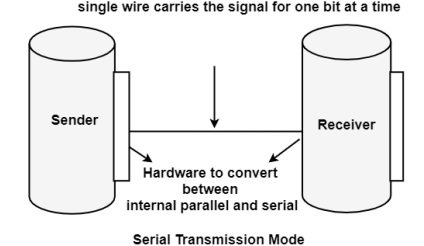
 Data Structure
Data Structure Networking
Networking RDBMS
RDBMS Operating System
Operating System Java
Java MS Excel
MS Excel iOS
iOS HTML
HTML CSS
CSS Android
Android Python
Python C Programming
C Programming C++
C++ C#
C# MongoDB
MongoDB MySQL
MySQL Javascript
Javascript PHP
PHP
- Selected Reading
- UPSC IAS Exams Notes
- Developer's Best Practices
- Questions and Answers
- Effective Resume Writing
- HR Interview Questions
- Computer Glossary
- Who is Who
What is Serial Transmission?
The alternative to parallel transmission, called serial transmission, sends one bit at a time. With the importance of speed, it may seem that anyone designing a data communications system would choose parallel transmission. However, most communication systems use serial mode.
Following are the two main reasons for serial transmission−
- First, serial networks can be continued over long distances at much less cost because fewer physical wires are required, and intermediate electronic elements are less cheap.
- Second, using only one physical wire defines that there are never timing issues caused by one wire being slightly higher than another (a difference of millimetres can be essential in a high-speed communication system).
It can use serial transmission. The sender and receiver must include a small amount of hardware that changes data from the parallel form used in the machine to the serial structure used on the wire.
The figure given below shows the configuration−

The hardware needed to convert data between an internal parallel form and a serial form can be straightforward or complex, depending on the type of serial communication mechanism. In the simplest case, a single chip that is known as a Universal Asynchronous Receiver and Transmitter (UART), performs the conversion. A related chip, Universal Synchronous-Asynchronous Receiver and Transmitter (USART) handles conversion for synchronous networks.
Types
There are three types of Serial Transmission which are as follows−
- Asynchronous transmission: It can occur at any time, with an arbitrary delay between the transmissions of two data items.
- Synchronous transmission: It can occur continuously with no gap between the transmissions of two data items.
- Isochronous transmission: It can occur at regular intervals with a fixed gap between the transmissions of two data items.

